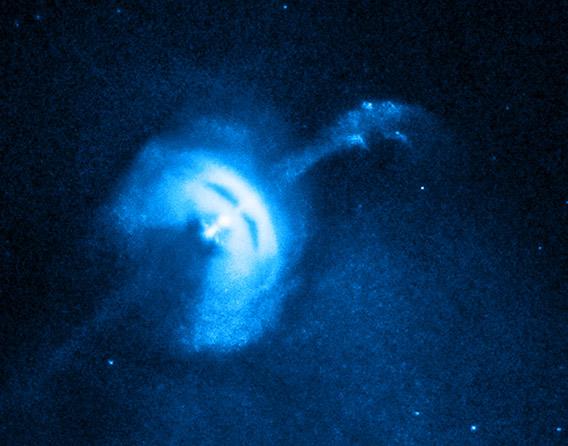The Universe is a weird place. I mean, seriously, how else would you describe something like the Vela pulsar? It used to be a massive star, far larger than the Sun. Then it exploded, blasting away an octillion tons of debris at high velocity. But even as the outer layers blew away, the core collapsed. Enough material to make an entire star like the Sun got squeezed down into a tiny ball just a few kilometers across.
This neutron star, as this object is called, is a place of mind-crushing extremes: a surface gravity billions of times that of Earth, a temperature in the millions of degrees, and a magnetic field billions of times Earth’s as well. And it spins, oh, how it spins, that entire mass whirling madly more than 11 times every second!
And we’re not done: All of these forces combine to generate two beams of matter of energy that scream away from the poles of the star, blasting outward at 70 percent of the speed of light! That’s fast enough to get to from the Earth to the Moon in two seconds flat, in case you were still not flabbergasted by all this. New observations of this beam indicate it’s not steady, either. It appears to make a corkscrew pattern every 120 days as it floods away from the pulsar. Here’s a video made from the observations:
Isn’t that bizarre? What we think is happening is that the pulsar is wobbling as it spins. If you’ve ever spun a top, you’ve seen that as it slows down it starts to wobble, the axis making a slow circle even as the top itself continues to spin. This is called precession, and happens when a spinning object has an off-center force on it. For the top, it’s friction with the floor. For a pulsar, it could be that the material in the star is a bit off-center, making it lopsided, throwing off the spin. But whatever the cause it, it forces the axis of the pulsar to make that slow wobble once every 120 days or so.

Image credit: X-ray: NASA/CXC/Univ of Toronto/M.Durant et al; Optical: DSS/Davide De Martin; Cartoon Network
The observations to make the animation were from the Chandra X-ray Observatory. The material blasting away from the star is so hot it generates X-rays which can be detected from Earth. It’s amazing, even from a distance of 1000 light years, that you can easily see the emission from the pulsar in the center, the beam itself, and the gas near the pulsar being heated up by the fierce wind of subatomic particles from the star—that gas actually looks a bit like a distorted face, doesn’t it? I keep thinking it looks like Brak from Space Ghost.
I’ll note that the reason we call this a pulsar is because at some wavelengths of light (usually radio, but also sometimes visible light as well) the neutron star sweeps a hot spot around as it spins, toward and away from the Earth, like the beam of a light house. When it’s on the side facing us we see a blip of light, and when it turns to the other side we see the light dim. This happens several times per second for many of these objects—making the term “pulsar” fairly apt.
I’ve been fascinated by pulsars and neutron stars since I was a kid. I mean, seriously: it’s the mass of an entire star, and it spins a dozen times per second. Some are even faster; millisecond pulsars spin hundreds of times per second, faster than the blades on a kitchen blender! And it’s a whole freakin’ star!
Like I said: The Universe is a weird place. But it’s fun, isn’t it?
